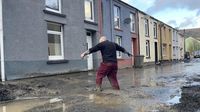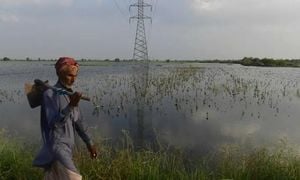One year has passed since a devastating landslip struck the former coal tip above Cwmtillery, Blaenau Gwent, forcing dozens of residents from their homes in the dead of night. Triggered by the torrential rains of Storm Bert in November 2024, the landslip sent thousands of tonnes of sodden earth and debris cascading down the hillside, with mud and water reportedly reaching residents’ windows. The event, described by the Welsh Government as a “singular wash-out of former coal tip in the area,” reignited long-standing fears about the legacy of Wales’s coal mining past and the safety risks posed by hundreds of disused tips scattered across the valleys.
This week, Deputy First Minister Huw Irranca-Davies returned to the scene to assess the progress made over the past twelve months. Standing alongside officials from Blaenau Gwent County Borough Council and the Mining Remediation Authority, Irranca-Davies reflected on the harrowing images from a year ago. “The scenes from Cwmtillery last year will always stay with me,” he said, according to Nation.Cymru and ITVX. “Returning to Cwmtillery twelve months on, I’m pleased to see the substantial progress made to support this community and make the site safer.”
The improvements at the site are tangible. Over the past year, engineers and council officers have installed new drainage systems, reprofiled the slopes, and introduced measures to better manage water flow—each step designed to reduce the risk of future landslides or erosion during heavy rainfall. The scheme has been supported by £610,000 from the Welsh Government’s Coal Tip Safety Grant Scheme, itself part of a much larger joint investment with the UK Government now totaling more than £220 million. These funds have not only enabled the urgent repairs at Cwmtillery, but have also supported enhanced inspections and maintenance at high-risk sites across Wales, particularly during spells of adverse weather.
Yet, as recent events have shown, the threat lingers. Just last week, heavy rain from Storm Claudia again raised concerns about the vulnerability of old coal workings. Councillor Tommy Smith, Cabinet Member for Neighbourhoods and Environment at Blaenau Gwent Council, acknowledged the ongoing anxiety within the community. “Our thoughts remain with all residents affected by the landslide in Cwmtillery,” he said. “Working closely with partners, we have carried out extensive investigations and remedial works at the disused tip site. This includes improved drainage systems to divert water away and ongoing investigations into any further measures required such as reprofiling.”
Smith also stressed the importance of keeping residents involved in the process. “We have got to listen to the community going forward and take onboard their concerns,” he told ITVX. “We are working with engineers and officers to understand what further work can take place at the tip, and that may involve re-profiling of the tip in the future.” Monitoring of the site continues, particularly during severe weather, and the council is “fully committed to this work, supporting the local community, and keeping residents informed every step of the way.”
In the aftermath of the Cwmtillery landslip, the Welsh Government has ramped up its efforts to address the broader issue of coal tip safety. Since November 2024, around 800,000 homes across Wales have been signposted to advice about disused coal tips, as authorities continue to inspect potentially dangerous sites. The scale of the challenge is formidable: there are 2,573 recorded coal tips in Wales, and 368 of these are classified in the highest risk categories—Category C and D—which means they have the potential to impact public safety directly.
To tackle these risks head-on, the Welsh Government has enacted significant legislative reform. The Disused Mine and Quarry Tips (Wales) Act, which passed through the Senedd earlier this year and received Royal Assent in September 2025, lays the groundwork for a new era of tip management and public safety. Central to the Act is the creation of the Disused Tips Authority, a new national body based in Merthyr Tydfil and set to open its doors in April 2027. The Authority will employ around 60 staff and will be tasked with cataloguing, assessing, and inspecting all disused tips across Wales, introducing a long-term management system designed to reduce the risks to communities living in their shadow.
Deputy First Minister Irranca-Davies reaffirmed the government’s commitment to this ambitious agenda. “We remain absolutely dedicated to protecting people and ensuring communities living in the shadow of former tips are safe, both now and in the future,” he said. This commitment is being put to the test as climate change brings more frequent and intense storms, increasing the likelihood of similar disasters in the years ahead.
The political debate around coal tip safety has also sharpened. Plaid Cymru MP Ann Davies, representing Caerfyrddin, has voiced the lingering fears of communities across the valleys. “The truth is that families in Cwmtillery, and in villages across our valleys are still going to bed fearing the hillside above them,” Davies said, as reported by Nation.Cymru. “Unfortunately, as extreme weather becomes more frequent, particularly heavy rainfall, there is an increased risk of more coal tip disasters, which is why urgent action is essential.” Davies has called attention to the historical injustices faced by mining communities, pointing out that while the UK Government benefited from the coal industry’s wealth, the burden of its dangerous legacy now falls on local residents. “Our coalmining communities were stripped of their wealth, and it was the UK Government that reaped the rewards. Now, it is our communities that are facing the dangerous burden of their legacy.”
Last month, Davies led a debate in Westminster, urging the UK Government to fully fund the remediation work needed to make coal tips safe. “Our communities should never pay the price for the negligence of past governments,” she argued, echoing calls for a more equitable approach to funding and responsibility.
Meanwhile, the Welsh Government’s new safety and awareness campaign seeks to ensure that residents are better informed and prepared. The campaign, launched alongside the legislative reforms, is part of a broader push to raise public awareness about the risks associated with disused coal tips and the steps being taken to mitigate them. Local authorities, the Mining Remediation Authority, and now the soon-to-be-established Disused Tips Authority are all working to provide reassurance and transparency as they carry out inspections, maintenance, and, where necessary, major engineering works.
For the people of Cwmtillery, the memory of last year’s landslip remains vivid. The scars on the landscape—and the anxieties about what lies beneath—are not easily healed. But as the community marks this difficult anniversary, the progress made over the past year offers a measure of hope. With new infrastructure in place, strengthened government oversight, and a growing recognition of the need for urgent action, there is cautious optimism that the mistakes of the past will not be repeated.
As Wales continues to grapple with the legacy of its industrial heritage, the story of Cwmtillery stands as both a warning and an example—a reminder that vigilance, investment, and community engagement are essential to keeping people safe in the shadow of the valleys’ coal-stained hills.




